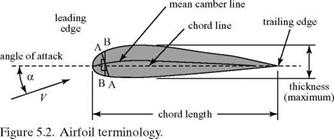Airfoil-Shape Parameters
An airfoil shape is usually perceived as a symmetric thickness envelope distributed above and below a mean camber line (camber is a measure of the curvature of an
|
|
airfoil). The chord line is a straight line joining the two ends of the mean camber line, which are termed the leading edge and the trailing edge and are depicted in Fig. 5.2.
Strictly speaking, the thickness envelope is defined as measured along a line perpendicular to the mean camber line (e. g., A-A). However, if the maximum camber is small, then the thickness distribution may be defined as symmetrical above and below the mean camber line as measured in a direction perpendicular to the chord (e. g., B-B). For small camber, the difference between A-A and B-B is minor. Following are the major parameters that define an airfoil shape:
1. Camber (curvature): The shape of the mean line of the airfoil. This shape is usually expressed in terms of camber distribution (i. e., distance to the chord line as a function of chord length) and camber ratio (i. e., maximum camber as a percentage of chord).
2. Thickness: Usually expressed in terms of thickness distribution (i. e., the height of the airfoil relative to the mean camber line approximately the chord line, as a function of chord length) and thickness ratio (e. g., the maximum thickness of the airfoil expressed as a percentage of chord).
3. Nose radius: (radius of a circle fitted to the nose).
4. Slope of the airfoil at the trailing edge: (angle between the camber line and chord line at the trailing edge).
Expressing maximum camber and maximum thickness as a ratio with the chord is convenient because an airfoil of given camber and thickness can appear to the flow as a large or a small obstacle, depending on the relative magnitude of the chord. It follows from these definitions that a symmetrical airfoil has zero camber, with the thickness distributed symmetrically about the chord line.












